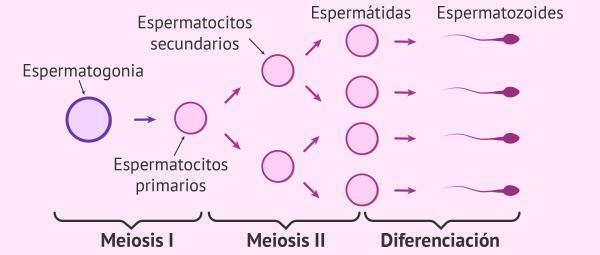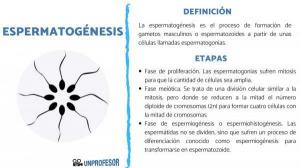What are secondary SPERMATOCYTES and their PHASES

Spermatocytes should not be confused with the familiar sperm. In fact, not even spermatocytes are the same as secondary spermatocytes. They are all the product of certain phases of the spermatogenesis process, that is, the birth of the sperm, the gamete or male sex cell. These, which are, together with the ovules, the key to sexual reproduction in animals, go through a complex system until they are ready in their final form.
If you want to learn what secondary spermatocytes are, join us in this lesson from a TEACHER.
Index
- What are secondary spermatocytes
- Proliferative phase
- Meiotic phase
- Sperm phase
What are secondary spermatocytes.
The secondary spermatocytes they are one of the many phases of the male gamete formation process. It is one of the last phases, specifically the one that precedes the spermatid. To understand its place and function well, it is necessary to talk about the entire process of spermatogenesis.
The process known as spermatogenesis is the one in which the
male gametes of animals, sperm. In an adult male, the entire process lasts between 75 and 90 days.The process is especially important because reproductive cells are special in their DNA load: they are haploid. All other cells in the body are diploid, meaning they carry two copies of DNA, one from each parent. If the cells did not have this double charge, which is called 2n, serious problems and dysfunctions would appear.
However, with reproductive cells the opposite occurs: they need to have only half the load so that, when the sperm unites with the ovum, a new healthy zygote is produced with the appropriate genetic load resulting from the union of both. To get these haploid cells, you have to go through a process of several phases, one of which is secondary spermatocytes.

Image: Assisted reproduction
Proliferative phase.
This is the first phase spermatogenesis, and is also called the phase spermatogon. Starts during puberty, when the reproductive system is activated due to the high levels of testosterone that appear.
It occurs in seminiferous tubules, small tubes located inside the testicles, which are the male gonads. Here they are formed type A spermatogonia starting from a germ stem cell, the first of the many changes and stages that will have to take place before reaching the goal: sperm.
Type A spermatogonia divide by mitosis, which is the common process of cell division in which the cell divides by replicating its genetic material in full, giving rise to a new cell with the same endowment genetics. New spermatogonia will emerge from this mitosis type A and type B. Type A will keep replicating over and over again giving rise to more spermatogonia both A and B to increase the number of both.

Image: Assisted reproduction
Meiotic phase.
Also called spermatocytic phase. In it, the B spermatogonia, unlike the A spermatogonia, will give rise to a primary spermatocyte. It is the phase in which the all-important change from diploid to haploid, in which the cell's DNA load is divided in two, giving rise to new cells with half the chromosomes: no duplicated genetic load. From a diploid cell, four haploid cells will eventually emerge, which will eventually become a sperm.
During the meiosis I, the primary sperm will have to undergo changes. Through chromosomal crossover, that is, the exchange of genetic material between their pairs of chromosomes, gives rise to unique individuals, with a unique combination of DNA fragments, the secondary spermatocyte, the star of our lesson.
However, the two secondary spermatocytes generated from the primary spermatocyte are still diploid, so they are not yet ready to function as reproductive cells. You have to meiosis II, in which each secondary spermatocyte divides once more, now, in two haploid cells, with half the chromosomes of any other cell. Are the spermatids.
Spermiogenic phase.
Spermatids are almost ready to do their job: are immature sperm. To be able to act as sperm they still need the unique morphological characteristics that allow them to reach the egg and fertilize it: its tail and head.
The maturation process that allows them to develop these characteristics las between 2 and 3 months. The cytoplasm is reduced giving rise to a smaller and more pointed head, and the tail that the spermatid was already beginning to present grows, giving rise to the flagellum.
Once the sperm are mature, they are released to the center of the seminiferous tubule where they are ready to be ejaculated. However, in order to fertilize the egg they will need to pass a last training process, that in natural circumstances occurs while they travel through the reproductive tract of the woman to the ovum. This process, however, can also be artificially replicated by performing techniques such as in vitro fertilization.
This whole process, in which the primary and secondary spermatocytes have played their vital role, to end up reaching the sperm: a gamete 60 microns long that, thanks to its unique morphology, can travel at a speed of 3 millimeters per minute. It's a lot for something its size.

Image: Lifeder
If you want to read more articles similar to What are secondary spermatocytes, we recommend that you enter our category of biology.
Bibliography
- Bruce M. Carlson. Editorial Elsevier Health Sciences. (2019) Human Embryology and Developmental Biology
- Norberto López Serna. Editorial McGRAW-HILL INTERAMERICANA (2012) Developmental Biology. Work notebook

![ORGANS of the circulatory system and their FUNCTIONS [with images]](/f/4e8868df816b5be4b60d7c674887f607.jpg?width=300&height=200)

